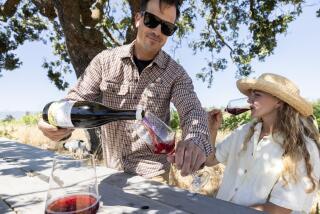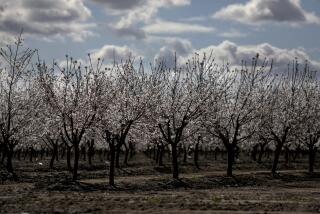Abalone : It takes two years to grow one small mollusk, but biologists are trying to make all that time pay off with a crop that will be a big hit with gourmets.
- Share via
PORT HUENEME — Restaurateurs were skeptical in the early 1980s when John McMullen appeared at their back door hawking baby abalone in pails of salt water.
“When I first tried to pound them, they would zip across the room like a shooting star,” recalls Michael Hutchings, chef and owner of elegant Michael’s Waterside Inn in Santa Barbara.
But with prices for full-grown abalone skyrocketing and supplies dwindling because of pollution and over-harvesting, Hutchings decided to give the idea some thought. McMullen, a marine biologist who grew the mollusks himself, was proposing a new market--2-inch abalone appetizers that enterprising chefs could poach in Pernod, saute in drawn butter or top with a dollop of golden caviar.
Aquaculture Pioneer
Now, six years later, Hutchings dishes up about 100 appetizers of three baby abalone a week at $12 a pop, and McMullen runs a burgeoning business supplying the delicacy to upscale eateries such as Trumps in West Hollywood and the Ranch House in Ojai.
McMullen, 42, is one of the pioneers of abalone farming--which has existed on a small scale since the mid-1970s from Ventura up the Pacific Coast as far as Seattle, but is now poised for big growth, those in aquaculture say.
Only a few firms currently raise abalone--that temperamental shellfish whose mother-of-pearl-lined shell conceals a meaty delicacy. But dwindling supplies of wild abalone, new farming methods and the public’s growing taste for young abalone has stirred interest among investors and entrepreneurs.
“Five years ago, nobody was making a penny. It was all research and promotion,” says Frank Oaks, who runs the Abalone Farm near San Luis Obispo. Today, Oaks says he has raised $1.5 million from investors and plans to expand his operations from a capacity of 300,000 to 3 million abalone.
McMullen says he also will soon move his Ab Lab from Port Hueneme to larger quarters in Oxnard and more than triple his abalone farm from a capacity of 600,000 to 2 million.
Whether he and others succeed in cracking the broader shellfish market remains to be seen. The long lead time--almost two years are needed to grow a 2-inch appetizer-sized abalone--may discourage some growers. (No one has yet figured an economic way to raise adult abalone, which would take five to seven years.) But others take heart in the fact that the mollusk demands top dollar.
“With wild abalone getting so scarce and the price so high, the future looks very good for cultured abalone,” says George Ray, secretary of the San Diego-based California Aquaculture Assn.
Demand for Appetizers
Pollution and over-harvesting have virtually erased wild abalone from menus and shot the price past $30 per pound, when they are available. The once commonplace “abalone almondine steak” on California seafood restaurant menus is mostly history.
But those in the abalone farming business credit McMullen for creating a demand for abalone hors d’oeuvres which others are now scrambling to supply.
“John has opened up a market that no one thought would ever be there,” says Andrew Davlin Jr., whose Abalone Unlimited in the Morro Bay area is planning to have the capacity to grow 12 million abalone.
Hutchings says the sight of three tiny abalone sauteed in drawn butter with enoki mushrooms makes epicures at his restaurant salivate in anticipation. “I’ve had tremendous success. It’s one of the signatures on my menu.”
Thanks to customers such as Hutchings, McMullen isn’t doing poorly himself.
He sells up to 40,000 appetizer-size abalone to restaurants annually at $1.35 each. Shipping is no problem: La Sena Restaurant in Santa Fe, N.M., receives its orders in ice-packed chests via overnight air delivery.
Another 500,000 of his smaller abalone go to other growers who raise them to at least appetizer-size. McMullen says he isn’t worried about supplying his competitors; he figures that promoting growth and enlarging the market will benefit everyone.
Others buy his remaining 60,000 tiny abalone each year and plant them on coastal rocks offshore to replenish the diminishing wild stock.
The Greater Los Angeles Council of Divers and Southern California Edison, for instance, are attempting to give newly planted abalone a running start on predators by housing them in specially designed devices called “habitats”--open-ended plastic pipes wrapped in chicken wire. The narrow pipe keeps octopuses and starfish at bay, protecting the quarter-sized shellfish until they crawl out of the pipe in search of a dark, rocky spot to settle.
Encouraged by State
Earl Ebert, a marine resources supervisor for the California Department of Fish and Game, calls the reseeding operations “critically important.” He says the wild abalone harvest has dwindled from 4 million pounds annually in the mid-1960s to 500,000 at present, and the future of California abalone depends on operations such as McMullen’s.
“It’s nice to have that seed available for replanting,” adds Mary Stein, a commercial abalone diver based on Santa Catalina Island whose trade group, the California Abalone Assn., buys up to 10,000 1-inch seedlings a year from McMullen. Commercial divers are prohibited by law from harvesting wild abalone of less than five inches in diameter, and some varieties are protected until they reach seven inches, Stein said.
McMullen says his annual sales approach $100,000--up sixfold from several years ago. Clad in tennis shoes, jeans and a T-shirt that reads, “Americans for Marine Eco-balance,” McMullen putters around a lab where flasks, tubs, and scales are crammed in genial disarray. The dank smells of the sea permeate Ab Lab headquarters, a metal shack on a leased, quarter-acre plot at the Navy Scientific Research Center in Port Hueneme.
He is negotiating with Southern California Edison for permission to build a $2-million hatchery and nursery on a five-acre site the utility owns in Oxnard. McMullen wants to raise the abalone to quarter-inch size on land here, then transport them to facilities off the coast of Chile and Washington state, which offer the protected bays and inlets where abalone flourish.
But tending to abalone is nowhere as easy as shooting fish in a barrel.
Bureaucratic hassles can be daunting. Monterey Abalone Farms tangled with local governmental agencies on the Monterey Peninsula over environmental permits in the early 1980s. Frustration finally led owner George Lockwood to move his operation to Hawaii in 1984. Others complain that the permit process--which includes approvals from the California Coastal Commission and the U.S. Army Corps of Engineers--can take years.
4,000-Year History
Then there’s the high attrition rate. Only 5% of the abalone spawn make it to plump, two-year specimens that restaurants favor. While growing, the abalone must be nurtured with kelp, exposed to correct amounts of sunlight and supplied with fresh, clean salt water.
On the flip side, abalone farmers say their products are sweeter and more tender than those grown in the wild.
Aquaculture in general has come a long way since the Chinese first dabbled in it 4,000 years ago. Today, rainbow trout are raised in Idaho; catfish in the South; oysters and salmon in Washington. Nationwide, the sea farming industry harvested 600 million pounds of fish and logged $500 million in sales during 1986, according to the National Marine Fisheries Service.
But abalone are more temperamental than oysters or mussels, and biologists say that only a handful of people so far have successfully farmed them.
It wasn’t until 1964, for instance, that a Japanese scientist, Katashi Ino, outlined the abalone life cycle in a landmark aquaculture paper. For that, he is dubbed the “father of abalone culture.”
With the help of government subsidies, abalone farming thrives today in Japan and Taiwan. By contrast, the industry is still emerging in the United States.
McMullen has spent 15 years researching the abalone life cycle. He has about 150 “breeder” abalone, some up to 13 years old, which he coaxes to spawn by injecting a chemical into their water.
For the first six months, abalone larvae live in big plastic buckets as they grow from specks of dust to seedlings the size of a fingernail. At that point, McMullen sorts them and sells most of his crop to other growers.
Ravaged by Storms
The rest he places in barrels with wire mesh that he dumps overboard at Port Hueneme’s harbor. The barrels are anchored to the ocean bottom, and algae and water flow through to supply the growing abalone with food.
Divers check on the charges once a week to make sure predators such as octopus and sea otters haven’t broken through the wire screens. After nine months, the abalone have grown to 2-inch size and are ready to be “harvested.”
Storms, however, can quickly ravage an abalone crop, and McMullen estimates he lost about 6,000 2-inch shellfish during squalls last winter.
Like a number of his peers, McMullen has tinkered with growing abalone for years but says he is only now starting to make a respectable living at it.
He was first bitten by the shellfish bug in 1971 while attending California State University, Northridge. For his senior project, McMullen attempted to raise abalone in a hatchery he built himself. The endeavor saw minor success, but long after the class ended, McMullen doggedly pursued his project in his brother’s back yard.
While his wife worked to support them, McMullen experimented with raising abalone in Ventura County. In the mid-1970s, he grew the shellfish by strapping buckets of tiny abalone to oil platform pilings off the Oxnard coast. Today, Ab Lab employs five, and McMullen says he does abalone “consulting” work for growers in Tasmania, Japan, Canada and South America.
But he rarely sits down to a meal that includes abalone appetizers. “That,” he says, “would be like eating money.”
More to Read
Inside the business of entertainment
The Wide Shot brings you news, analysis and insights on everything from streaming wars to production — and what it all means for the future.
You may occasionally receive promotional content from the Los Angeles Times.










